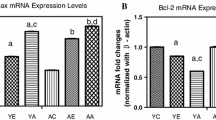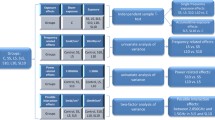Abstract
The effect of decimetric microwaves (DMW) on the activity of pyruvate kinase (PK), one of the energy supply enzymes, was investigated in the brain structures of 3-, 6-, and 24-month-old white outbred male rats. Experimental rats were exposed on a daily basis to 10 and 30 µW/cm2 of DMW radiation for 20 min over a period of 10 days. It was established that PK activity in the cortical and subcortical brain structures, which differ in their oxygen supply, morphofunctional and phylogenetic characteristics, reacts differently to the effect of DMW: at 10 µW/cm2 it increases while at 30 µW/cm2 it decreases. In mitochondrial subcellular fractions of the brain structures, PK activity was lower at 10 µW/cm2 than at 30 µW/cm2. In cytosolic subcellular fractions, no significant differences were revealed in PK activity at different intensities of DMW radiation, while these indicators, taken separately, were significantly different compared to the control (p < 0.01; p < 0.001). There are two alternative assumptions to explain the obtained results. An increased PK activity in the brain structures studied may reflect a metabolic adaptation aimed at protecting the structural integrity and functional components of nerve cells from detrimental effects of DMW radiation. Conversely, energy deficiency due to a decline in PK activity, in turn, causes various negative secondary metabolic changes and a free-radical oxidation in nerve cells. Our data reveal that both at 10 and 30 µW/cm2 of DMW radiation the endogenous signals in the rat brain spread from cortical to subcortical structures, but PK activity does not recover to the level of the control values. It is hypothesized that under the effect of DMW radiation, the cerebellum, orbital and sensorimotor cortices serve as donors while the limbic cortex and hypothalamus as acceptors in the system of signal transduction.



Similar content being viewed by others
REFERENCES
Lipskaya, T.Y. and Voinova, V.V., Mitochondrial nucleoside diphosphate kinase: mode of interaction with the outer mitochondrial membrane and proportion of catalytic activity functionally coupled to oxidative phosphorylation, Biochemistry (Moscow), 2008, vol. 73(3), pp. 321–331. https://doi.org/10.1134/S0006297908030139
Eser, O., Songur, A., Aktas, C., Karavelioglu, E., Caglar, V., Aylak, F., Ozguner, F., and Kanter, M., The effect of electromagnetic radiation on the rat brain: an experimental study, Turk. Neurosurg., 2013, vol. 23(6), pp. 707–715. https://doi.org/10.5137/1019-5149.JTN.7088-12.2
Grigoryev, Yu.G., Mobile phone and unfavorable influence on the user’s brain: a risk assessment, Rad. Biol. Radioekol., 2014, vol. 54(2), pp. 215–216. https://doi.org/10.7868/S0869803114020052
Krause, C.M., Sillanmäki, L., and Koivisto, M., Effects of electromagnetic fields emitted by cellular phones on the electroencephalogram during a visual working memory task, Int. J. Radiat. Biol., 2000, vol. 76(12), pp. 1659–1667. https://doi.org/10.1080/09553000050201154
Sit’ko, S.P., Life as the fourth level of the quantum organization of nature, Energy and Information Transfer in Biological Systems, pp. 293–307. 2003. https://doi.org/10.1142/9789812705181_0014
Hirazova, E.E., Bayzhumanov, A.A., Trofimova, L.K., Maslova, M.V., Sokolova, N.A., and Kudryashova, N.Yu., Influence of GSM electromagnetic radiation on some physiological and biochemical characteristics of rats, Byull. Eksper. Biol. Med., 2012, vol. 153(6), pp. 816–819. https://doi.org/10.1007/s10517-012-1833-2
Yashin, A.I., Resonance effects in the interaction of the electromagnetic fields with the biosystems. I. Types of resonances and their physico-biological models, J. New Med. Technol., 2018, vol. 2, pp. 127–143. https://doi.org/10.24411/2075-4094-2018-16005
Zosangzuali, M.Z., Lalramdinpuii, M., and Ganesh, C.J., Impact of radiofrequency radiation on DNA damage and antioxidants in peripheral blood lymphocytes of humans residing in the vicinity of mobile phone base stations, Electromagnet. Biol. Med., 2017, vol. 36(3), pp. 295–305. https://doi.org/10.1080/15368378.2017.1350584
Radon, K., Parera, D., Rose, D.-M., Jung, D., and Vollrath, L., No effects of pulsed radio frequency electromagnetic fields on melatonin, cortisol and selected markers of the immune system in man, Bioelectromagnetics, 2001, vol. 22(4), pp. 280–287. https://doi.org/10.1002/bem.51
Samoilov, M.O. and Rybnikova, E.A., Molecular-cellular and hormonal mechanisms of induced tolerance of the brain to extreme environmental factors, Neurosci. Behav. Physiol., 2013, vol. 43(7), pp. 827–837. https://doi.org/10.1007/s11055-013-9813-1
Rashidova, A.M., Dynamics of energy supply enzymes in the rat brain against the background of exposure to stress factors, Zh. Ukr. Tovar. Genet. Selek.—Vіsn. Ukr. Tovar. Genet. Selek., 2019, vol. 17(1), pp. 16–32. https://doi.org/10.7124/visnyk.utgis.17.1.1197
Rashidova, A.M., Effect of pre-/postnatal hypoxia on pyruvate kinase in rat brain, Int. J. Sec. Metab., 2018, vol. 5(3), pp. 224–232. https://doi.org/10.21448/ijsm.450963
Khazipov, R., Zaynutdinova, D., Ogievetsky, E., Valeeva, G., Mitrukhina, O., Manent, J.-B., and Represa, A., Atlas of the Postnatal Rat Brain in Stereotaxic Coordinates, Front. Neuroanat., 2015, vol. 9, p. 161. https://doi.org/10.3389/fnana.2015.00161
Chinopoulos, C., Zhang, S.F., Thomas, B., Ten, V., and Starkov, A.A., Isolation and functional assessment of mitochondria from small amounts of mouse brain tissue, Meth. Mol. Biol., 2011, vol. 793, pp. 311–324. https://doi.org/10.1007/978-1-61779-328-8_20
Rashidova, A.M., Babazadeh, S.N., Mamedkhanova, V.V., and Abiyeva, E.Sh., Dynamics in the enzymes activity in brain of rat exposed to hypoxia, Biotechnol. Acta, 2019, vol. 12(4), pp. 42–49. https://doi.org/10.15407/biotech12.04.043
Kruger, N.J., Bradford method for protein quantitation, The Protein Protоcols Handbook, 2nd ed., Walker, J.M., Ed., Humana Press Inc., Totowa N.J., 2002, pp. 15–21. https://www.springer.com/gb/book/9781588298805
Semenza, G.L., Hypoxia-inducible factors in physiology and medicine, Cell, 2012, vol. 148(3), pp. 399–408. https://doi.org/10.1016/j.cell.2012.01.021
Reisz, J.A., Bansal, N., Qian, J., Zhao, W., and Furdui, C.M., Effects of ionizing radiation on biological molecules—mechanisms of damage and emerging methods of detection, Antioxid. Redox Signal., 2014, vol. 21(2), pp. 260–292. https://doi.org/10.1089/ars.2013.5489
Rashidova, A.M. and Gashimova, U.F., Peculiarities of the dynamics of pyruvate kinase activity in cytosol of brain structures in irradiated young and adult rats, Sb. Tr. Mezhd. Konf. «Radioekologiya-2017», Kiev, 2017, pp. 210–213. https://doi.org/10.7124/visnyk.utgis.17.1.1197
Rashidova, A.M., Hashimova, U.F., and Gadimova, Z.M., Study of energy metabolism enzymes and state of cardiovascular system in elderly and senile age patients, J. Adv. Gerontol., 2020, vol. 10(1), pp. 86–93. https://doi.org/10.1134/s2079057020010130
Titorenko, V.I., Molecular and cellular mechanisms of aging and age-related disorders, Int. J. Mol. Sci., 2018, vol. 19(7), p. 2049. https://doi.org/10.3390/ijms19072049
Anisimov, V.N. and Khavinson, V.Kh., Peptide bioregulation of aging: results and prospects, Biogerontol., 2009, vol. 11(2), pp. 139–149. https://doi.org/10.1007/s10522-009-9249-8
Malavolta, M., Caraceni, D., Olivieri, F., and Antonicelli, К., New challenges of geriatric cardiology: from clinical top reclinical research, Geriat. Cardiol., 2017, vol. 14(4), pp. 223–232. https://doi.org/10.11909/j.issn.1671-5411.2017.04.005
Dabbous, H.K., Mohamed, Y.A.E., El-Folly, R.F., El-Talkawy, M.D., Seddik, H.E., Johar, D., and Sarhan, M.A., Evaluation of fecal M2PK as a diagnostic marker in colorectal cancer, J. Gastrointest. Cancer, 2019, vol. 50(3), pp. 442–450. https://doi.org/10.1007/s12029-018-0088-1
Huang, J.X., Zhou, Y., Wang, C.H., Yuan, W.W., Zhang, Zd., and Zhang, X.F., Tumor M2-pyruvate kinase in stool as a biomarker for diagnosis of colorectal cancer: a meta-analysis, J. Can. Res. Ther., 2014, vol. 10 (Suppl. S3), pp. 225–228. https://doi.org/10.4103/0973-1482.145886
Lukyanova, L.D., Mitochondria signaling in adaptation to hypoxia, Int. J. Physiol. Pathophysiol., 2014, vol. 5(4), pp. 363–381. https://doi.org/10.1615/IntJPhysPathophys.v5.i4.90
Pellerin, L. and Magistretti, P.J., How to balance the brain energy budget while spending glucose differently, J. Physiol., 2003, vol. 546(2), p. 325. https://doi.org/10.1113/jphysiol.2002.035105
Rashidova, A.M. and Hashimova, U.F., Age-dependent activity of lactate dehydrogenase in brain structures during postnatal ontogenesis of rats exposed to hypoxia in the fetal period, J. Evol. Biochem. Physiol., 2019, vol. 55(3), pp. 172–178. https://doi.org/10.1134/S0044452919030124
Harman, D., Free radical theory of aging: an update increasing the functional life span, Ann. NY Acad. Sci., 2006, pp. 10–21. https://doi.org/10.1196/annals.1354.003
Tapio, S. and Jacob, V., Radioadaptive response revisited, Radiat. Environ. Biophys., 2007, vol. 46(1), pp.1–12. https://doi.org/10.1007/s00411-006-0078-8
Martinovich, G.G., Martinovich, I.V., Cherenkevich, S.N, and Sauer, H., Redox buffer capacity of the cell: theoretical and experimental approach, Cell Biochem. Biophys., 2010, vol. 58(2), pp. 75–83. https://doi.org/ 10.1007/s12013-010-9090-3
Funding
This work was supported by the Azerbaijan National Academy of Sciences (0111AZ321 N 27.21: 20.27.25).
Author information
Authors and Affiliations
Corresponding author
Ethics declarations
COMPLIANCE WITH ETHICAL STANDARDS
All applicable international, national and institutional principles of handling and using experimental animals for scientific purposes were observed.
This study did not involve human subjects as research objects.
CONFLICT OF INTEREST
Authors of this study have not conflict of interest.
Additional information
Russian Text © The Author(s), 2021, published in Zhurnal Evolyutsionnoi Biokhimii i Fiziologii, 2021, Vol. 57, No. 2, pp. 154–164https://doi.org/10.31857/S0044452921020066.
Translated by A. Polyanovsky
Rights and permissions
About this article
Cite this article
Rashidova, A.M. Differential Effects of Decimetric Electromagnetic Microwaves on Pyruvate Kinase Activity in the Rat Brain during Ontogenesis. J Evol Biochem Phys 57, 241–251 (2021). https://doi.org/10.1134/S002209302102006X
Received:
Revised:
Accepted:
Published:
Issue Date:
DOI: https://doi.org/10.1134/S002209302102006X




